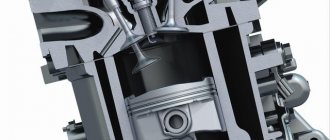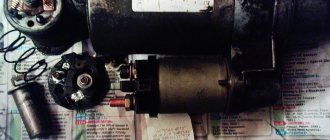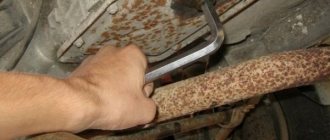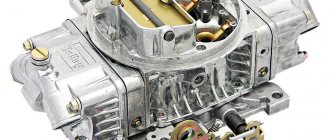A manual transmission has its advantages over an automatic transmission, and many drivers still prefer it when buying a car. One of the advantages of mechanics is its unpretentiousness, as well as the low cost of repairs in case of damage to the elements of the box, compared to an automatic variation.
A common symptom indicating that there is some problem with the transmission is that it makes a crunching noise when changing gears. If you hear a crackling or crunching sound when moving the gearshift lever and engaging gears, you need to contact a service center as soon as possible.
Important: You should contact a service center not only because of the likelihood of causing more serious damage to the gearbox and other mechanisms, but also because of the risk of an accident if the gearbox fails.
How does a crunching sound manifest in a gearbox?
There is an unspoken rule among drivers - to start driving a car with the radio turned off. This is necessary to immediately check whether there are any extraneous knocks, noises or other sounds that may indicate a malfunction of a particular unit. The following sounds will indicate problems with the gearbox:
- A crunching sound when engaging a gear, and often it can only appear in one of the gears, for example, in reverse;
- Crackling noise when returning the gearshift lever to neutral.
If you notice one or both of the symptoms in the operation of your box, you should determine and eliminate the cause as soon as possible.
Unsuitable oil
The transmission can be damaged if the wrong oil is used.
“The requirements for a modern gearbox oil are: good fluidity over the operating temperature range, reliable wear protection, excellent synchronization, high oxidation and shear stability, low tendency to foam, good seal compatibility, high efficiency,” says Vyacheslav Mikhailovich.
Different types of gearboxes require special gear oils recommended by the manufacturer. If the oil is selected incorrectly, slippage and vibration begin, fuel consumption increases, wear increases, and the oil can burn.
Why does the gearbox crunch?
There are many reasons why a crunching noise occurs when the gearbox operates. Eliminating some of them does not require much intervention in the mechanism, while others require a near-overhaul of the box. Most often, the gearbox crunches when changing gears for the following reasons:
Synchronizer malfunction. The problem may lie either in the failure of the element or in the insufficient amount of lubricant in the part. If the synchronizer has “crumbled” due to age, the lubricating components with the resulting “garbage” risk causing serious damage to the entire unit, so the situation needs to be corrected as soon as possible;
Worn bearings
If a grinding noise appears in the gearbox when you shift into gear, but the sound disappears when you shift to neutral, this may indicate wear on the bearings. If these bearings are not replaced in time, the box may jam, which will lead to expensive repairs.
“It is recommended to check the transmission in accordance with the requirements of the car manufacturer. It needs systematic visual inspection. Care must be taken to ensure that oil does not leak. In addition, dirt should not get there, otherwise the gears will shift worse,” advises mechanical engineer Andrey Semenov .
How to avoid crunching noises in the gearbox
Most often, gearbox malfunction occurs due to improper care of it. Manual transmissions require regular lubrication, which drivers often forget about, assuming that such procedures are only required for automatic transmissions. If the lubricant loses its properties, this can lead to serious consequences, including failure of individual components and mechanisms.
Experts recommend replacing the lubricant in a manual transmission every 45-50 thousand kilometers. If the vehicle is driven under particularly severe conditions, change the oil more often.
Please note: It is especially important to promptly change the lubricant on a front-wheel drive vehicle.
By lubricating gearbox and suspension elements in a timely manner, you can avoid expensive repairs and early failure.
Hello everyone. The second gear shifts with a crunch. I know it's synchronous. Tell me, how much does a synchronous replacement cost and how long can you drive?
Bolts from casting will be used for dies
by Adminrive · Published 10/24/2015
It seems to be a little cold
by Adminrive · Published 05/12/2016
The transmission is noisy in neutral and howls at speed.
Main causes of malfunction:
- insufficient oil level in the manual transmission. If there is a lack of transmission fluid, the lubrication of the rubbing pairs deteriorates. Thermal expansion and dry friction leads to noise and howling when moving. If the car has covered hundreds of thousands of kilometers, you should not be alarmed by slight noise when operating in neutral. We recommend limiting yourself to only changing the oil in the manual transmission.
If extraneous noise from the gearbox occurs when the clutch is depressed, the release bearing is faulty.
- gear wear. The reason is the development of gear teeth at the contact points. In this case, only replacing worn parts will help eliminate noise and howling;
- wear of the bearings of the driven, drive or intermediate shaft. As a result of oil starvation, heavy loads, increased torque after boosting the engine, or natural wear, abrasions, scuffing and uneven performance appear on the rolling elements and bearing races;
- production of differential parts for front-wheel drive cars. In such cases, vibrations are common when accelerating.
Some VAZ models are worthy of a special note, in which the manual transmission begins to make noise, howl and vibrate at relatively short distances. Many people attribute the malfunction to a design defect and the quality of manufacturing of transmission parts, which makes the idea of any repair very doubtful.
Gears engage poorly and with a crunch
Difficulty shifting gears and a metallic grinding noise at the moment of shifting are clear signs of a malfunction of the manual transmission synchronizers. But before removing the gearbox for repairs, check the gear selector and clutch. Play in the gearshift lever, cable jamming, and incorrect adjustment of the gear selection mechanism lead to unclear and often poor gear shifting. And incomplete disengagement of the clutch after pressing the pedal (the clutch is moving) will cause crunching and grinding sounds. Driving with such a malfunction will quickly damage the synchronizers.
If your car only shifts into second or, for example, third gear with a crunch, then the problem is most likely with the synchronizers. These elements are intended to equalize the rotation speed of the output shaft and the gear engaged in the transmission. Wear of the conical friction part leads to slipping of the blocking ring and rigid engagement of the clutch with the gear teeth. When disassembling and troubleshooting, you should also pay attention to gears, gear clutches and their forks.
Knocks out the speed
The synchronizer blocking ring and gears have specially shaped teeth with which the clutch engages when changing speeds. If the coupling splines, teeth on the ring and gear are ground down, then when the load is applied and the gas pedal is released, the transmission spontaneously switches off. In this case, it will not be possible to limit yourself to replacing synchronizers; you should definitely change the gear of the damaged transmission and the gear shift clutch.
Failures that cause crunching when changing gears
Crunching noise when shifting gears can be caused by several factors. The first and, admittedly, most popular is considered to be the breakdown of any unit, and the crunch in this case is only a symptom. Among the main breakdowns that cause such unpleasant sounds when switching gears are: 1. Failure of synchronizers . Synchronizers are responsible for smooth gear shifting. Over time, they wear out and cause a crunching sound when changing gears. Fixing the problem is quite easy - you need to replace these same synchronizers. However, only professionals should be trusted to carry out this type of repair. 2. The falling out of the clutch basket can also cause a crunching sound when changing gears. Replacing the clutch basket will eliminate this defect. 3. Clutch malfunction . Well, here words are superfluous - go for diagnostics, they will establish an accurate diagnosis. 4. Problems related to the gearbox shaft . The problem can be solved by replacing this unit.
How to properly adjust the rocker on a VAZ 2110?
This method is used, as a rule, when the first method did not produce results.
- Turn on first speed.
- Loosen the rocker
. - Turn the rocker
counterclockwise until the gearshift lever begins to rest against the plastic reverse speed stop. - Tighten the clamp and check how everything works.
Interesting materials:
How to scan your phone for viruses through a computer? How to disconnect iPad from phone? How to unlink an Instagram account from your phone? How to disconnect MI Fit from your phone? How to unlink a phone number from Steam without a verification code? How to unlink a phone number from an account? How to unlink a phone number from WhatsApp? How to unlink email from Steam from your phone? How to unlink an old phone from apple id? How to unlink an old phone from a new one?
Incorrect operation of the transmission, as the cause of a crunching sound when shifting gears
It is fair to say that often a crunching sound when shifting gears may indicate that the manual transmission is not being used properly. Therefore, it would not be amiss to provide some recommendations that will extend the service life of the manual transmission.
1. Timely replacement of transmission fluid in the box . Few people know, but in a manual transmission, just like in an automatic transmission, the oil should be changed periodically. A manual transmission does not require replacement as often as an automatic transmission, but still, after 70,000 kilometers, you should stop by a service station. If you ignore this recommendation, metal shavings and dirt will begin to accumulate in the oil, resulting in insufficient lubrication and crunching.
2. An insufficient amount of oil in the transmission can also cause a crunching sound when shifting gears. The solution is to add oil or, better yet, replace it .
As you can see, it’s quite easy to avoid crunching noise when changing gears!
TOP 6 common mistakes with manual transmission
Shifting gears without clutch
It sounds very strange, given the type of gearbox, but beginners and drivers who have been driving an automatic for a long time often forget to depress the clutch when shifting.
The result is a strong crunch, and a quick realization of the mistake made. At these moments, the box experiences unforeseen loads due to the fact that at the moment of switching the box is not disconnected from the engine, and therefore is under load. Sometimes such pranks end in licking or, even worse, breaking off fragments of gear teeth. As a result, the mechanism “grinds” itself and the manual transmission is simply inevitable.
Clutch depressed
Many car enthusiasts systematically hold the clutch pedal depressed for a long time. For example, when they are standing at traffic lights or just stopped.
This, at first glance, harmless action leads to increased wear of the clutch disc, but what “suffers” the most is the release bearing, which is tirelessly forced to rotate under load. As a result, it quickly becomes unusable (it buzzes), as a result of which it will require immediate replacement, because there is a risk that it will “scatter” right on the move. By the way, to replace it you will have to remove the box, which is not a cheap pleasure.
Engaging reverse gear without coming to a complete stop
A classic of the genre, the driver tries to quickly turn around in the yard, in a hurry, first and then reverse gears. We hear an unpleasant grinding noise when we obviously try to engage the rear.
The reason is simple: the pilot is trying to engage reverse without making a full stop. This has an extremely negative effect on the teeth of the reverse gears, which slowly become unusable due to licking off on one side. If such an error becomes permanent, the reverse gear will engage worse and worse from time to time, until it completely fails.
Downshifting by two or more
Due to the fact that in a manual transmission the function of selecting gears is assigned to the driver, there is a high probability of engaging an inappropriate gear. In cases with downshifts, this is especially dangerous. After all, if the wheel speed turns out to be higher than the maximum possible in the gear selected by the driver (cutoff), when the clutch is released, extreme engine braking will occur. As a result, not only can the gearbox and clutch fail, but also the timing belt in the engine can jump over a couple of teeth (the chain is no exception, but less often), or even break completely (usually an expensive repair).
In addition, with such sharp engine braking, the drive wheels will slow down momentarily, incomparably with the speed of the car, which can cause the car to fall off the trajectory when turning, especially in winter.
If you drive a manual transmission, you should know which gear is which “maximum speed” and avoid “wrong” downshifts.
Hand on the lever
Many drivers, when moving, keep their hand on the gearshift lever, as if on an armrest.
On the one hand, it seems to be convenient, on the other hand, it loosens the mechanism and “kills” the forks that directly move the clutches in the gearbox. Those who want to save the box must understand that while driving the car oscillates chaotically and the driver does not consciously hold on to everything his hands are on. As a result, the load on the lever turns out to be not so small, and the box loses its original “tightness”
Released clutch
As you know, the clutch is an integral part of a manual transmission. It is involved in the process of shifting gears (discussed above) and “taking off” from a place. The most detrimental thing is slipping of the clutch disc at the moment of start. Because the entire assembly gets very hot and simply wears out due to friction. Some drivers do not know about this and use the clutch incorrectly, thereby significantly reducing its service life.
For example, when standing on an incline in a drag, they hold the car in place by not fully grasping the clutch (the clutch pedal is not fully released) or they drive onto a curb/obstacle not due to inertia (at low speeds), as needed. And due to the moment of clutch engagement. Alas, the clutch will not serve its intended life this way. And the work to replace it will cost a pretty penny, because you will have to pay not only for new spare parts, but also for dismantling the box.
Results
Everyone makes their own decision whether to pay attention to all of the above or not. On my own behalf, I will add that due to the design features, the mechanics themselves are very reliable, and the only thing that can quickly “ruin” them is incorrect actions by the driver. Follow your iron friend and he will never let you down.
Well done author! And skidding is also harmful. At any checkpoint.
Vip07007, 10. You will be acquitted.
Possible causes of malfunction
Very often, problems with uninterrupted gear shifting when the engine is turned off arise due to breakdowns of the synchronizers in the gearbox. The cause of the malfunction may also be gear wear or breakage. There may also be malfunctions of the mechanisms and components responsible for transmitting force from the lever to the gearbox when the driver turns on the speed.
In order to accurately determine the problem, you need to either remove the box to disassemble it and identify the fault, or find and replace failed components. Although often the usual prevention is enough: adjustments and lubrication.
Table of faults and their elimination
| Manual transmission malfunction | Cause and remedy |
| One or all gears do not engage | Wear, broken synchronizers (broken teeth), broken clutch basket petals, a problem with the fork or release bearing, a broken shaft or gears, faulty linkages to the manual transmission (they may need to be adjusted with the replacement of plastic bushings), low oil level, or the wrong transmission fluid has been filled ( maybe water got in) |
| Noise in neutral when the engine is running | Wear of the bearing (drive gear or drive shaft), low level of lubrication, dirty (worn out oil), ingress of dirt or water, it happens that there is a malfunction in the shaft itself (for example, it is overheated initially) |
| Noise when gears are engaged (in all gears) – the engine is running | The same reasons as in neutral, the bearing of the output shaft or driven gear has collapsed, the clutch and engine housings are not aligned |
| Noise in one gear engaged, engine running | The synchronizer is broken, the teeth of this gear are worn out |
| Crunch when switching | Clutch malfunction (basket, disc), drive does not work (cable breaks, fluid leaks), synchronizer wear, gear malfunction, sometimes the box unscrews itself (you need to check the fastening) |
| Gears disengage on their own (either when accelerating or when resetting) | Problem with synchronizers, broken gears, damaged gear forks, destruction of shaft bearings, manual transmission unscrewed, damaged gear shift rods |
| Vibration from manual transmission when engine is running | The power unit itself operates unevenly, the manual transmission has come loose, the fastenings to the body are broken, the supports are destroyed |
| Oil leak from manual transmission | The oil drain plug is leaking, oil seals and O-rings are leaking, there is too much oil inside, the manual transmission housing is broken (cracks have appeared as a result of impacts) |
This is not all, but the most common reasons, of course, to eliminate them you need qualified help; you are unlikely to do anything yourself, if only because removing a manual transmission, especially on a front-wheel drive one, is not so easy. The thing is that the main faults lie inside and in order to identify them, in any case you need to remove your gearbox.











